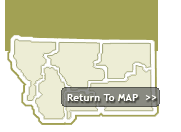

| Home | Communities | Accommodations | Places To Go | Things To Do | Site Map |
|
Glacier Country
Central Montana
Missouri River Country
Southwest Montana
Yellowstone Country
Southeast Montana
|

| ||||
 Hardin is situated on the banks of the Bighorn River. The Bighorn Canyon and Dam allow a majestic view of the water below.
Hardin is situated on the banks of the Bighorn River. The Bighorn Canyon and Dam allow a majestic view of the water below. Hardin sits on the edge of the Crow Indian Reservation. The reservation offers two mountain ranges, the rugged Pryor and Bighorn mountains, with rolling hills and semi-arid plains surrounding the peaks.
The town is surrounded by productive ranches and farms, including the largest wheat farm in the world. Coal mining has also contributed greatly to the local economy. Nearby lies the Northern Cheyenne Indian Reservation.

South of Hardin is the Little Bighorn Battlefield, where the Northern Plains Indians defeated Custer and the U.S. Army.
The world famous Custer's Last Stand Reenactment is one of Custer Country's biggest annual attractions, an annual event celebrated in Hardin. Sioux, Northern Cheyenne, and Arapaho warriors under the leadership of Sitting Bull, Crazy Horse, and Gall fight George Armstrong Custer's Seventh Cavalry troopers. The reenactment script is based on Crow Tribal Elder Joseph Medicine Crow's translation of oral and written Native American narrative beginning before Lewis and Clark's epic journey almost 200 years ago. Presentations have a newly expanded emphasis on the impact of the explorers' travels, to be commemorated with a much-heralded Lewis and Clark bicentennial in 2003-2006. The sweeping pageantry of high plains history is portrayed by over 200 participants, including descendants of the troopers, Indian warriors, and scouts involved in the original battle. It is listed as one of the 'Top 100 Events in America' by Destinations magazine.

Elevation: 2,902 feet.
Hardin is located in south-central Montana, 45 miles southeast of Billings on I-90.
Hardin AccommodationsBed & Breakfast (2)Hotel/Motel (5) Lodge (1) Private Campground (4) Hardin RestaurantsFamily Restaurant (3)Pizza Parlor (1) | All Hardin BusinessesArt Gallery (1)Banking Service (1) Chamber Of Commerce (1) Church (3) Fishing Access Site (4) Marina (1) Museum (1) Outfitter/Guide (3) Public Golf Course (1) Specialty Store (1) Visitor Information Center (1) |
Cities near Hardin Montana
| Acton Ballantine Bighorn Billings Bridger | Crow Agency Custer Fort Smith Garryowen Hardin | Huntley Project Hysham Ingomar Lodge Grass Melstone | Mussellshell Pryor Roundup Sanders Shepherd | St. Xavier Sumatra Wyola |
A source for Montana Travel & Tourism Information
![]()